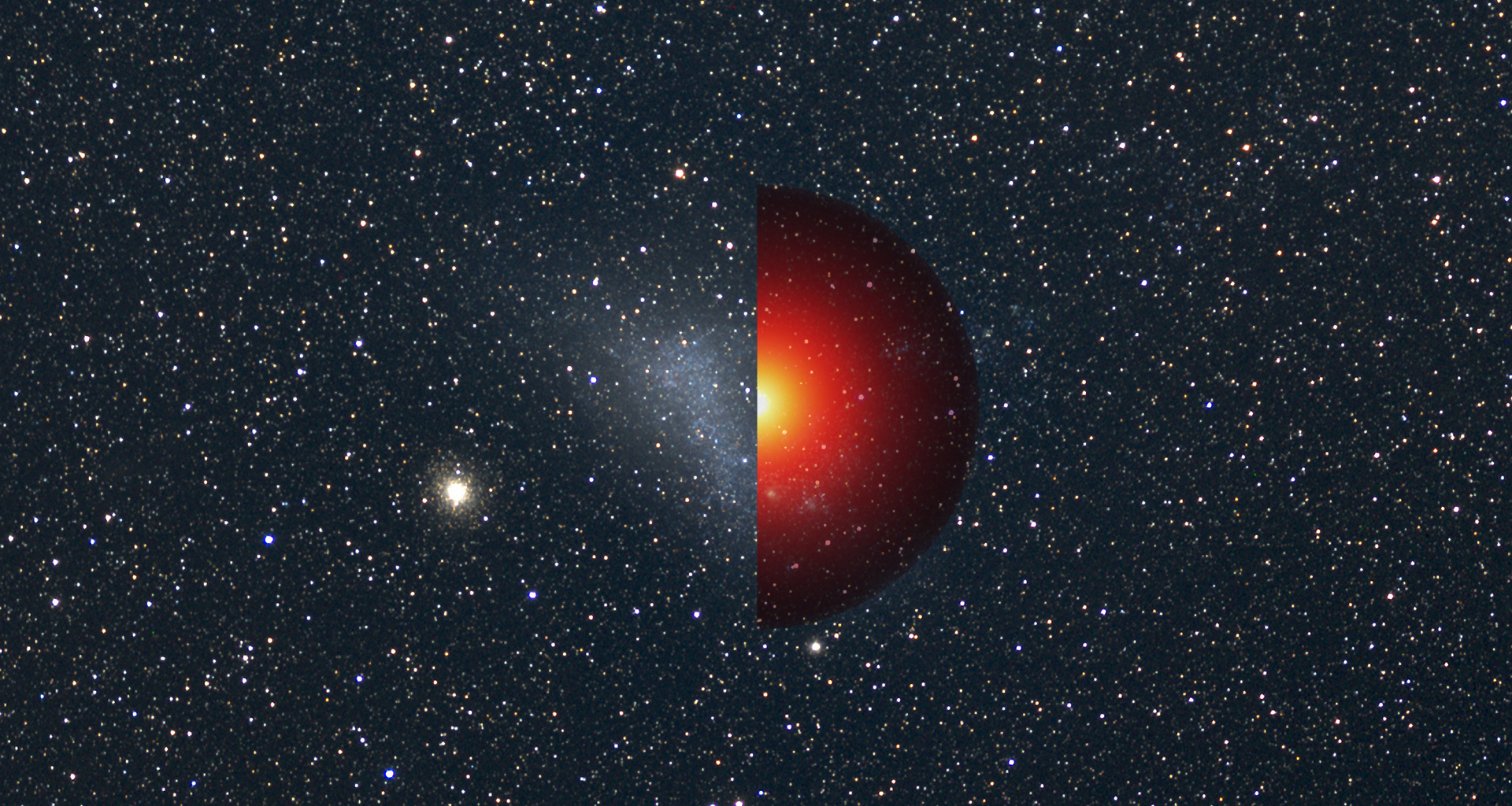Fermi Hints at Dark Matter
Using public data from NASA's Fermi Gamma-ray Space Telescope, independent scientists at the Fermi National Accelerator Laboratory, Harvard University, MIT and the University of Chicago have developed new maps showing that the galactic center produces more high-energy gamma rays than can be explained by known sources and that this excess emission is consistent with some forms of dark matter.
No one knows the true nature of dark matter, but WIMPs, or Weakly Interacting Massive Particles, represent a leading class of candidates. Theorists have envisioned a wide range of WIMP types, some of which may either mutually annihilate or produce an intermediate, quickly decaying particle when they collide. Both of these pathways end with the production of gamma rays — the most energetic form of light — at energies within the detection range of Fermi's Large Area Telescope (LAT).
The galactic center teems with gamma-ray sources, from interacting binary systems and isolated pulsars to supernova remnants and particles colliding with interstellar gas. It's also where astronomers expect to find the galaxy's highest density of dark matter, which only affects normal matter and radiation through its gravity. Large amounts of dark matter attract normal matter, forming a foundation upon which visible structures, like galaxies, are built.
When the astronomers carefully subtract all known gamma-ray sources from LAT observations of the galactic center, a patch of leftover emission remains. This excess appears most prominent at energies between 1 and 3 billion electron volts (GeV) — roughly a billion times greater than that of visible light — and extends outward at least 5,000 light-years from the galactic center. The researchers find these features difficult to reconcile with other explanations proposed, such as undiscovered pulsars. The gamma-ray spectrum of the excess, its symmetry around the galactic center and its overall brightness, is, however, consistent with annihilations of dark matter particles in the mass range of 31 and 40 GeV.
The scientists note that discoveries in other astronomical objects, such as dwarf galaxies, and experiments on Earth designed to directly detect dark matter particles will be needed to confirm this interpretation.
For more information: Fermi Data Tantalize With New Clues To Dark Matter
This animation zooms into an image of the Milky Way, shown in visible light, and superimposes a gamma-ray map of the galactic center from NASA's Fermi. Raw data transitions to a view with all known sources removed, revealing a gamma-ray excess hinting at the presence of dark matter.
The final file below—labeled MPEG—is an animated GIF.
Visible light imagery provided by Axel Mellinger, Central Michigan Univ.
Credit: NASA Goddard/A. Mellinger (Central Michigan Univ.) and T. Linden (Univ. of Chicago)

Side-by-side maps, with labels. At left is a map of gamma rays with energies between 1 and 3.16 GeV detected in the galactic center by Fermi's LAT; red indicates the greatest number. Prominent pulsars are labeled. Removing all known gamma-ray sources (right) reveals excess emission that may arise from dark matter annihilations.
Credit: T. Linden (Univ. of Chicago)

Side-by-side maps, without labels. At left is a map of gamma rays with energies between 1 and 3.16 GeV detected in the galactic center by Fermi's LAT; red indicates the greatest number. Prominent pulsars are labeled. Removing all known gamma-ray sources (right) reveals excess emission that may arise from dark matter annihilations.
Credit: T. Linden (Univ. of Chicago)
Movie, no labels, dissolving from the unprocessed map to one with sources removed and back to unprocessed. Details as above.
The first file—labeled MPEG—is an animated GIF.
Credit: T. Linden (Univ. of Chicago)
Movie, with labels, dissolving from the unprocessed map to one with sources removed and back to unprocessed; details as above.
The first file—labeled MPEG—is an animated GIF.
Credit: T. Linden (Univ. of Chicago)
Frames and video of dissolve sequence from unprocessed to background removed.
Credit: T. Linden (Univ. of Chicago)

A view of the entire gamma-ray sky from Fermi's LAT instrument, shaded to emphasize the central galaxy. The inset is a map of the galactic center with known sources removed, which reveals the gamma-ray excess (red, green and blue) found there. This excess emission is consistent with annihilations from some hypothesized forms of dark matter.
Credit: NASA/DOE/Fermi LAT Collaboration and T. Linden (Univ. of Chicago)
Credits
Please give credit for this item to:
NASA's Goddard Space Flight Center. However, individual images should be credited as indicated above.
-
Video editor
- Scott Wiessinger (USRA)
-
Producer
- Scott Wiessinger (USRA)
-
Scientist
- Tim Linden (University of Chicago)
-
Science writer
- Francis Reddy (University of Maryland College Park)
-
Graphics
- Francis Reddy (University of Maryland College Park)
Release date
This page was originally published on Thursday, April 3, 2014.
This page was last updated on Wednesday, May 3, 2023 at 1:51 PM EDT.
Missions
This visualization is related to the following missions:Series
This visualization can be found in the following series:Datasets used in this visualization
-
[Fermi: LAT]
ID: 216Fermi Gamma-ray Large Area Space Telescope (GLAST) Large Area Telescope (LAT)
This dataset can be found at: http://fermi.gsfc.nasa.gov
See all pages that use this dataset -
[Fermi]
ID: 687
Note: While we identify the data sets used in these visualizations, we do not store any further details, nor the data sets themselves on our site.

